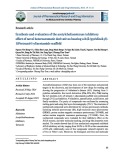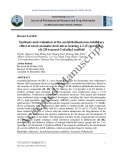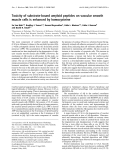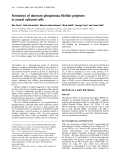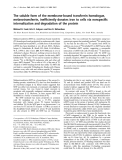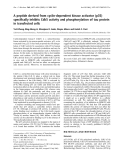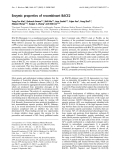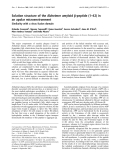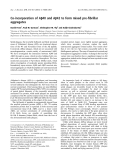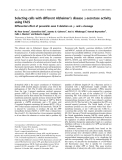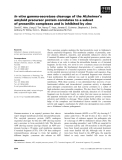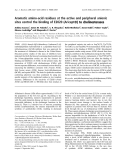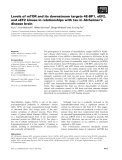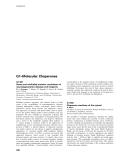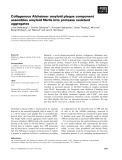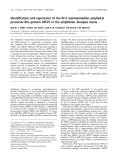
Alzheimer’s disease
-
Acetylcholinesterase (AChE) has been one of the important and potential targets in the discovery, and development of new drugs for treating and slowing the progression of Alzheimer's disease (AD). This research suggests potential structural frameworks for synthesizing AChE inhibitor derivatives for treating AD.
 11p
11p  vihyuga
vihyuga
 04-03-2025
04-03-2025
 1
1
 1
1
 Download
Download
-
Acetylcholinesterase (AChE) is a key therapeutic target for developing new Alzheimer's disease (AD) treatments due to its regulatory function in acetylcholine hydrolysis. This research contributed to the development of a novel scaffold for AChE inhibitors, which are potential drugs for treating AD.
 17p
17p  vihyuga
vihyuga
 04-03-2025
04-03-2025
 5
5
 1
1
 Download
Download
-
The main component of cerebral amyloid angiopathy (CAA) in Alzheimer’s disease is the amyloid-b protein (Ab), a 4-kDa polypeptide derived from the b-amyloid protein precursor (APP). The accumulation of Ab in the basement membrane has been implicated in the degeneration of adjacent vascular smooth muscle cells (VSMC). However, the mechanism of Ab toxicity is still unclear. In this study, we examined the effect of substrate-bound Ab on VSMC in culture. The use of substrate-bound proteins in cell culture mimics presentation of the proteins to cells as if bound to the basement membrane.
 9p
9p  system191
system191
 01-06-2013
01-06-2013
 45
45
 5
5
 Download
Download
-
Here we show, for the ®rst time, thein vitro formation of ®lamentous aggregates of phosphorylated tau protein in SH-SY5Y human neuroblastoma cells. The formation of suchaberrant aggregates, similar to thoseoccurringinvivoin Alzheimer's disease and other tauopathies, requires okadaic acid, a phosphatase inhibitor, to increase the level of phos-phorylated tau, and hydroxynonenal, a product of oxidative stress that selectively adducts and modi®es phosphorylated tau.
 6p
6p  research12
research12
 29-04-2013
29-04-2013
 34
34
 2
2
 Download
Download
-
Melanotransferrin (MTf) is a membrane-bound transferrin (Tf) homologue foundparticularly inmelanoma cells. Apart frommembrane-boundMTf, a soluble formof themolecule (sMTf) has been identified in vitro [Food, M.R., Rothen-berger, S., Gabathuler, R., Haidl, I.D., Reid, G. & Jefferies, W.A. (1994)J. Biol. Chem.269, 3034–3040] and in vivo in Alzheimer’s disease. However, nothing is known about the functionof sMTf or its role inFeuptake.
 11p
11p  research12
research12
 23-04-2013
23-04-2013
 22
22
 2
2
 Download
Download
-
Cyclin-dependent kinase-5 (Cdk5) is a serine/threonine kinase activated by its neuron-specific activator, p35, or its truncated form, p25. It has been proposed that the deregu-lation of Cdk5 activity by association with p25 in human brain tissue disrupts the neuronal cytoskeleton and may be involved in neurodegenerative diseases such as Alzheimer’s disease.
 8p
8p  research12
research12
 23-04-2013
23-04-2013
 33
33
 2
2
 Download
Download
-
BACE2 (Memapsin 1) is a membrane-bound aspartic pro-tease that is highlyhomologouswithBACE1 (Memapsin 2). While BACE1 processes the amyloid precursor protein (APP) at a key step in generating theb-amyloid peptide and presumably causes Alzheimer’s disease (AD), BACE2 has not been demonstrated to be directly involved in APP pro-cessing, and its physiological functions remain to be deter-mined.In vivo, BACE2 is expressed as a precursor protein containing pre-, pro-, protease, transmembrane, and cyto-solic domains/peptides....
 10p
10p  tumor12
tumor12
 22-04-2013
22-04-2013
 26
26
 2
2
 Download
Download
-
The major components of neuritic plaques found in Alzheimer disease (AD) are peptides known as amyloid b-peptides (Ab),which derive from the proteolitic cleavage of theamyloidprecursorproteins.InvitroAbmayundergoa conformational transition from a soluble form to aggrega-ted,fibrillary b-sheet structures,which seem to be neuro-toxic. Alternatively,it has been suggested that ana-helical form can be involved in a process of membrane poration, which would then trigger cellular death.
 7p
7p  tumor12
tumor12
 22-04-2013
22-04-2013
 39
39
 2
2
 Download
Download
-
Theb-amyloid peptide (Ab) is a major component of toxic amyloid plaques found in the brains of patients with Alzheimer’s disease.Abis liberated by sequential cleavage of amyloid precursor protein (APP) byb-andc-secre-tases.The level of Abdepends directly on the hydrolytic activity ofb-secretase.Therefore, b-secretase is an excel-lent target for drug design.An approach based on RNA-cleaving ribozymes was developed to control expression ofb-secretase.
 9p
9p  tumor12
tumor12
 20-04-2013
20-04-2013
 39
39
 4
4
 Download
Download
-
Senile plaques, the invariable hallmark and likely proximal cause of Alzheimer’s disease (AD), are structured deposi-tions of the 40- and 42-residue forms of the Abpeptide. Conversely, diffuse plaques, which are not associated with neurodegeneration, consist mainly of unstructured Ab42. We have investigated the interaction between Ab40 and Ab42 through an assay, which involves labeling both vari-ants with an environment-sensitive fluorophore.
 10p
10p  tumor12
tumor12
 20-04-2013
20-04-2013
 31
31
 3
3
 Download
Download
-
The ultimate step in Alzheimer’s disease Abgeneration involves c-secretase, which releases Abfrom its membrane-bound precursor. Asimilar presenilin-dependent proteolytic activity is implicated in the release of theNotch intracellular domain. We have developed a novel assay forc-secretase activity based on green fluorescent protein detection. This involves cotransfection of a substrate-activator based on the amyloid precursor protein or the Notch sequence and a fluorescent reporter gene.
 12p
12p  tumor12
tumor12
 20-04-2013
20-04-2013
 35
35
 4
4
 Download
Download
-
Thec-secretase complex mediates the final proteolytic event in Alzheimer’s disease amyloid-bbiogenesis. This membrane complex of presenilin, ante-rior pharynx defective, nicastrin, and presenilin enhancer-2 cleaves the C-terminal 99-amino acid fragment of the amyloid precursor protein intra-membranously atc-sites to form C-terminally heterogeneous amyloid-b and cleaves at ane-site to release the intracellular domain or e-C-terminal fragment.
 14p
14p  fptmusic
fptmusic
 12-04-2013
12-04-2013
 42
42
 5
5
 Download
Download
-
E2020 (R,S)-1-benzyl-4-[(5,6-dimethoxy-1-indanon)-2-yl]-methyl)piperidine hydrochloride isa piperidine-based ace-tylcholinesterase (AChE) inhibitor that was approved for the treatment of Alzheimer’s disease in the United States. Structure-activity studiesof thisclassof inhibitorshave indicated that both the benzoyl containing functionality and the N-benzylpiperidine moiety are the key featuresfor binding and inhibition of AChE.
 12p
12p  fptmusic
fptmusic
 12-04-2013
12-04-2013
 44
44
 2
2
 Download
Download
-
The pathogenesis of formation of neurofibrillary tangles (NFTs) in Alzhei-mer’s disease (AD) brains is unknown. One of the possibilities might be that translation of tau mRNA is aberrantly regulated in AD brains.
 10p
10p  fptmusic
fptmusic
 11-04-2013
11-04-2013
 63
63
 3
3
 Download
Download
-
Misfolded proteins, aggregates, and inclusion bodies are hall-marks of the cytopathology of neurodegenerative disorders including Huntington’s disease, Amyotropic lateral sclerosis, Parkinson’s disease, Prion diseases, and Alzheimer’s disease. The appearance of proteins with altered folded states is regula-ted by the protein folding quality control machinery and age-dependent. We have identified an unexpected molecular link between metabolic state, accumulation of damaged proteins, the heat-shock response and chaperones, and longevity....
 61p
61p  fptmusic
fptmusic
 11-04-2013
11-04-2013
 46
46
 5
5
 Download
Download
-
Protein aggregation is central to most neurodegenerative diseases, as shown by familial case studies and by animal models. A modified ‘amyloid cas-cade’ hypothesis for Alzheimer’s disease states that prefibrillar oligomers, also called amyloid-b-derived diffusible ligands or globular oligomers, are the responsible toxic agent. It has been proposed that these oligomeric spe-cies, as shown for amyloid-b, b2 -microglobulin or prion fragments, exert toxicity by forming pores in membranes, initiating a cascade of detrimental events for the cell. ...
 10p
10p  awards
awards
 06-04-2013
06-04-2013
 43
43
 3
3
 Download
Download
-
Neurodegenerative disorders, such as Huntington’s, Alzheimer’s, and Parkinson’s diseases, affect millions of people worldwide and currently there are few effective treatments and no cures for these diseases. Transgenic mice expressing human transgenes for huntingtin, amyloid precursor protein, and other genes associated with familial forms of neurodegenerative disease in humans provide remarkable tools for studying neurodegeneration because they mimic many of the pathological and behavioural features of the human conditions. ...
 15p
15p  awards
awards
 06-04-2013
06-04-2013
 39
39
 4
4
 Download
Download
-
Recently, a novel plaque-associated protein, collagenous Alzheimer amy-loid plaque component (CLAC), was identified in brains from patients with Alzheimer’s disease. CLAC is derived from a type II transmembrane colla-gen precursor protein, termed CLAC-P (collagen XXV). The biological function and the contribution of CLAC to the pathogenesis of Alzheimer’s disease and plaque formation are unknown.
 0p
0p  awards
awards
 06-04-2013
06-04-2013
 31
31
 2
2
 Download
Download
-
Numerous transmembrane proteins, including the blood pressure regulating angiotensin converting enzyme (ACE) and the Alzheimer’s disease amyloid precursor protein (APP), are proteolytically shed from the plasma membrane by metalloproteases. We have used an antisense oligo-nucleotide (ASO) approach to delineate the role of ADAM10 and tumour necrosis factor-aconverting enzyme (TACE;ADAM17) in theectodomainsheddingofACEand APP from human SH-SY5Y cells.
 9p
9p  dell39
dell39
 03-04-2013
03-04-2013
 57
57
 3
3
 Download
Download
-
The Alzheimer’s disease-linked amyloid-bprecursor pro-tein (APP) belongs to a superfamily of proteins, which also comprises the amyloid-b precursor-like proteins, APLP1 and APLP2. Whereas APP has been identified in both lower and higher vertebrates, thus far, APLP1 and 2 have been characterized only in human and rodents. Here we identify the first nonmammalian APLP2 protein in the South African claw-toed frogXenopus laevis.
 7p
7p  dell39
dell39
 03-04-2013
03-04-2013
 46
46
 4
4
 Download
Download
CHỦ ĐỀ BẠN MUỐN TÌM








